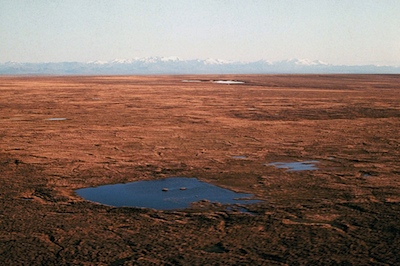The Tundra BiomeThe Arctic TundraWe find the arctic tundra biome at high latitudes closely associated with
the tundra climate.
Notable areas of
arctic tundra are found along the arctic coastal North America, Europe, Asia and Greenland.
Short grasses, flowers, and grass-like sedges, along with covers of mosses and lichens are
the dominate forms of vegetation in the tundra. Seasonal frost heave disrupts root systems
preventing support for tall vegetation. The arctic tundra looks like a treeless plain,
interrupted by patterned ground and an occasional tree in selected microenvironments. Figure 13.26 View
of the Alaskan Tundra. Pattern ground shown in Figure 13.25 is typical of the tundra landscape. Stone polygons, soil circles, stone or soil stripes and terraces are common to both arctic and alpine tundra. These features are created by thrusting action of repeated freezing and thawing of moist soil over a solid substrate like rock or permanently frozen ground. Polygonal patterns dominate flat surfaces. Vegetation is usually confined to the stable parts of the patterns.
|
